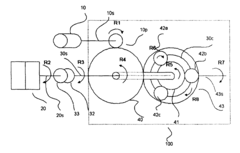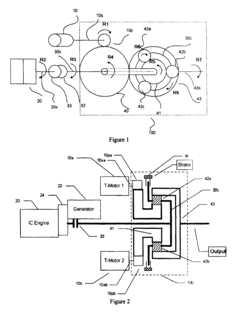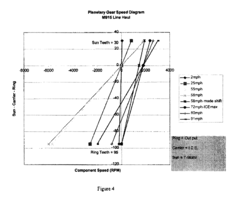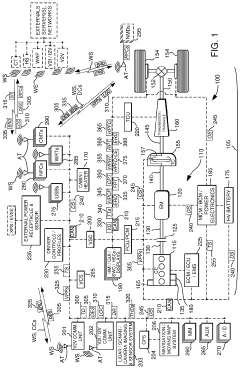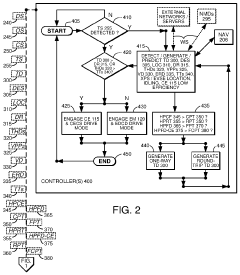The Future of HEV in Shared Mobility Platforms
AUG 14, 20259 MIN READ
Generate Your Research Report Instantly with AI Agent
Patsnap Eureka helps you evaluate technical feasibility & market potential.
HEV Technology Evolution and Objectives
Hybrid Electric Vehicles (HEVs) have undergone significant evolution since their inception in the late 20th century. Initially developed as a solution to reduce fuel consumption and emissions, HEVs have become increasingly sophisticated, incorporating advanced technologies to enhance performance, efficiency, and user experience. The primary objective of HEV technology in shared mobility platforms is to provide sustainable, cost-effective transportation solutions that meet the growing demand for eco-friendly urban mobility.
The evolution of HEV technology can be traced through several key milestones. Early HEVs utilized simple parallel hybrid systems, where electric motors supplemented internal combustion engines. As technology progressed, series-parallel hybrid systems emerged, offering greater flexibility in power management. More recently, plug-in hybrid electric vehicles (PHEVs) have gained prominence, allowing for extended electric-only driving ranges and further reducing emissions.
In the context of shared mobility platforms, HEV technology aims to address specific challenges such as frequent short trips, high daily mileage, and the need for quick refueling or recharging. The objectives for HEV technology in this sector include maximizing energy efficiency, minimizing operational costs, and ensuring high vehicle availability. These goals drive the development of more robust powertrains, advanced battery management systems, and intelligent energy management algorithms.
Looking ahead, the future of HEV technology in shared mobility platforms is focused on several key areas. One primary objective is to increase the electric-only driving range, allowing for a higher percentage of zero-emission miles in urban environments. This involves the development of higher capacity batteries and more efficient electric motors. Another crucial goal is to improve the integration of HEVs with smart city infrastructure, enabling features such as dynamic charging and intelligent traffic management.
Furthermore, HEV technology is evolving to enhance connectivity and automation capabilities. The integration of advanced driver assistance systems (ADAS) and eventual autonomous driving features is expected to improve safety and efficiency in shared mobility applications. Additionally, the development of predictive energy management systems that utilize real-time data and machine learning algorithms aims to optimize vehicle performance based on route characteristics and user behavior.
As shared mobility platforms continue to grow, HEV technology is also focusing on durability and longevity. This includes the development of more robust components that can withstand the high utilization rates typical in shared mobility scenarios, as well as advanced diagnostics and predictive maintenance systems to minimize downtime and extend vehicle lifespan.
In conclusion, the evolution of HEV technology for shared mobility platforms is driven by the need for sustainable, efficient, and reliable transportation solutions. The objectives encompass a wide range of technological advancements, from powertrain improvements to integration with smart infrastructure, all aimed at creating a more sustainable and user-friendly shared mobility ecosystem.
The evolution of HEV technology can be traced through several key milestones. Early HEVs utilized simple parallel hybrid systems, where electric motors supplemented internal combustion engines. As technology progressed, series-parallel hybrid systems emerged, offering greater flexibility in power management. More recently, plug-in hybrid electric vehicles (PHEVs) have gained prominence, allowing for extended electric-only driving ranges and further reducing emissions.
In the context of shared mobility platforms, HEV technology aims to address specific challenges such as frequent short trips, high daily mileage, and the need for quick refueling or recharging. The objectives for HEV technology in this sector include maximizing energy efficiency, minimizing operational costs, and ensuring high vehicle availability. These goals drive the development of more robust powertrains, advanced battery management systems, and intelligent energy management algorithms.
Looking ahead, the future of HEV technology in shared mobility platforms is focused on several key areas. One primary objective is to increase the electric-only driving range, allowing for a higher percentage of zero-emission miles in urban environments. This involves the development of higher capacity batteries and more efficient electric motors. Another crucial goal is to improve the integration of HEVs with smart city infrastructure, enabling features such as dynamic charging and intelligent traffic management.
Furthermore, HEV technology is evolving to enhance connectivity and automation capabilities. The integration of advanced driver assistance systems (ADAS) and eventual autonomous driving features is expected to improve safety and efficiency in shared mobility applications. Additionally, the development of predictive energy management systems that utilize real-time data and machine learning algorithms aims to optimize vehicle performance based on route characteristics and user behavior.
As shared mobility platforms continue to grow, HEV technology is also focusing on durability and longevity. This includes the development of more robust components that can withstand the high utilization rates typical in shared mobility scenarios, as well as advanced diagnostics and predictive maintenance systems to minimize downtime and extend vehicle lifespan.
In conclusion, the evolution of HEV technology for shared mobility platforms is driven by the need for sustainable, efficient, and reliable transportation solutions. The objectives encompass a wide range of technological advancements, from powertrain improvements to integration with smart infrastructure, all aimed at creating a more sustainable and user-friendly shared mobility ecosystem.
Shared Mobility Market Analysis
The shared mobility market has experienced significant growth in recent years, driven by urbanization, changing consumer preferences, and technological advancements. This sector encompasses various services, including ride-hailing, car-sharing, bike-sharing, and micro-mobility solutions. The global shared mobility market was valued at approximately $60 billion in 2020 and is projected to reach $205 billion by 2030, growing at a CAGR of 13.2% during the forecast period.
Ride-hailing services, dominated by companies like Uber and Lyft, constitute the largest segment of the shared mobility market. These platforms have revolutionized urban transportation, offering convenience and flexibility to users while challenging traditional taxi services. The ride-hailing segment accounted for over 70% of the total shared mobility market revenue in 2020.
Car-sharing services have also gained traction, particularly in densely populated urban areas where vehicle ownership can be costly and impractical. Companies like Zipcar and Car2Go have expanded their fleets and service areas, catering to consumers seeking short-term vehicle access without the burden of ownership. The car-sharing market is expected to grow at a CAGR of 24% from 2021 to 2028.
Micro-mobility solutions, including bike-sharing and e-scooter services, have emerged as popular last-mile transportation options in many cities. These services address the need for short-distance travel and complement existing public transportation systems. The global micro-mobility market is projected to reach $215 billion by 2030, growing at a CAGR of 17% from 2020 to 2030.
The adoption of shared mobility services varies across regions, with Asia-Pacific leading in terms of market size and growth potential. China, in particular, has seen rapid expansion of ride-hailing and bike-sharing services, driven by high population density and government support for sustainable transportation solutions. North America and Europe follow closely, with increasing adoption rates in major metropolitan areas.
The COVID-19 pandemic initially disrupted the shared mobility market, causing a sharp decline in ridership and revenue. However, the sector has shown resilience, adapting to new safety protocols and hygiene standards. As cities recover and mobility patterns evolve, shared mobility platforms are expected to play a crucial role in reshaping urban transportation landscapes.
Looking ahead, the integration of electric and hybrid vehicles into shared mobility fleets presents a significant opportunity for market growth and environmental sustainability. The shift towards cleaner transportation aligns with global efforts to reduce carbon emissions and combat climate change. This trend is likely to accelerate the adoption of HEVs in shared mobility platforms, offering both economic and environmental benefits to operators and users alike.
Ride-hailing services, dominated by companies like Uber and Lyft, constitute the largest segment of the shared mobility market. These platforms have revolutionized urban transportation, offering convenience and flexibility to users while challenging traditional taxi services. The ride-hailing segment accounted for over 70% of the total shared mobility market revenue in 2020.
Car-sharing services have also gained traction, particularly in densely populated urban areas where vehicle ownership can be costly and impractical. Companies like Zipcar and Car2Go have expanded their fleets and service areas, catering to consumers seeking short-term vehicle access without the burden of ownership. The car-sharing market is expected to grow at a CAGR of 24% from 2021 to 2028.
Micro-mobility solutions, including bike-sharing and e-scooter services, have emerged as popular last-mile transportation options in many cities. These services address the need for short-distance travel and complement existing public transportation systems. The global micro-mobility market is projected to reach $215 billion by 2030, growing at a CAGR of 17% from 2020 to 2030.
The adoption of shared mobility services varies across regions, with Asia-Pacific leading in terms of market size and growth potential. China, in particular, has seen rapid expansion of ride-hailing and bike-sharing services, driven by high population density and government support for sustainable transportation solutions. North America and Europe follow closely, with increasing adoption rates in major metropolitan areas.
The COVID-19 pandemic initially disrupted the shared mobility market, causing a sharp decline in ridership and revenue. However, the sector has shown resilience, adapting to new safety protocols and hygiene standards. As cities recover and mobility patterns evolve, shared mobility platforms are expected to play a crucial role in reshaping urban transportation landscapes.
Looking ahead, the integration of electric and hybrid vehicles into shared mobility fleets presents a significant opportunity for market growth and environmental sustainability. The shift towards cleaner transportation aligns with global efforts to reduce carbon emissions and combat climate change. This trend is likely to accelerate the adoption of HEVs in shared mobility platforms, offering both economic and environmental benefits to operators and users alike.
HEV Challenges in Shared Platforms
The integration of Hybrid Electric Vehicles (HEVs) into shared mobility platforms presents several significant challenges that need to be addressed for successful implementation. One of the primary obstacles is the higher initial cost of HEVs compared to conventional vehicles. While HEVs offer long-term cost savings through improved fuel efficiency, the upfront investment can be a deterrent for shared mobility operators looking to maintain competitive pricing.
Another challenge lies in the complexity of HEV powertrains, which may require specialized maintenance and repair services. This can lead to increased downtime for vehicles in shared fleets, potentially impacting service availability and customer satisfaction. Additionally, the need for specialized technicians and equipment can result in higher operational costs for shared mobility providers.
Battery life and performance degradation over time pose unique challenges in the context of shared mobility. The frequent charging cycles and high utilization rates typical in shared platforms may accelerate battery wear, potentially reducing the overall lifespan of HEVs in these fleets. This could necessitate more frequent vehicle replacements, impacting the long-term economic viability of HEV integration.
The charging infrastructure for HEVs in shared mobility platforms presents another set of challenges. While HEVs offer the flexibility of both electric and gasoline power, optimizing the balance between electric and conventional fuel usage in a shared context can be complex. Ensuring adequate charging opportunities without compromising vehicle availability requires careful planning and potentially significant investment in charging infrastructure.
User experience and adoption also present challenges. Shared mobility users may need education on the optimal use of HEVs, including understanding when to rely on electric power versus gasoline. This learning curve could initially impact user satisfaction and the efficiency gains expected from HEV technology.
Lastly, the regulatory landscape surrounding HEVs in shared mobility is still evolving. Varying incentives, emissions regulations, and urban planning policies across different regions can create a complex operating environment for shared mobility providers looking to deploy HEV fleets consistently across multiple markets.
Addressing these challenges will require collaborative efforts from vehicle manufacturers, shared mobility operators, policymakers, and technology providers. Innovative solutions in battery technology, fleet management systems, and user interface design will be crucial in overcoming these obstacles and realizing the full potential of HEVs in shared mobility platforms.
Another challenge lies in the complexity of HEV powertrains, which may require specialized maintenance and repair services. This can lead to increased downtime for vehicles in shared fleets, potentially impacting service availability and customer satisfaction. Additionally, the need for specialized technicians and equipment can result in higher operational costs for shared mobility providers.
Battery life and performance degradation over time pose unique challenges in the context of shared mobility. The frequent charging cycles and high utilization rates typical in shared platforms may accelerate battery wear, potentially reducing the overall lifespan of HEVs in these fleets. This could necessitate more frequent vehicle replacements, impacting the long-term economic viability of HEV integration.
The charging infrastructure for HEVs in shared mobility platforms presents another set of challenges. While HEVs offer the flexibility of both electric and gasoline power, optimizing the balance between electric and conventional fuel usage in a shared context can be complex. Ensuring adequate charging opportunities without compromising vehicle availability requires careful planning and potentially significant investment in charging infrastructure.
User experience and adoption also present challenges. Shared mobility users may need education on the optimal use of HEVs, including understanding when to rely on electric power versus gasoline. This learning curve could initially impact user satisfaction and the efficiency gains expected from HEV technology.
Lastly, the regulatory landscape surrounding HEVs in shared mobility is still evolving. Varying incentives, emissions regulations, and urban planning policies across different regions can create a complex operating environment for shared mobility providers looking to deploy HEV fleets consistently across multiple markets.
Addressing these challenges will require collaborative efforts from vehicle manufacturers, shared mobility operators, policymakers, and technology providers. Innovative solutions in battery technology, fleet management systems, and user interface design will be crucial in overcoming these obstacles and realizing the full potential of HEVs in shared mobility platforms.
Current HEV Solutions for Shared Use
01 Powertrain and energy management systems for HEVs
Hybrid Electric Vehicles (HEVs) utilize advanced powertrain and energy management systems to optimize performance and efficiency. These systems integrate electric motors with internal combustion engines, manage power distribution, and control energy flow between various components. They often include sophisticated control algorithms to balance power sources, maximize fuel efficiency, and reduce emissions.- Powertrain and energy management systems for HEVs: Advanced powertrain designs and energy management systems are crucial for optimizing the performance of hybrid electric vehicles. These systems integrate combustion engines with electric motors, manage power distribution, and improve overall efficiency. Key components include advanced battery management, regenerative braking systems, and intelligent control units that optimize the use of electric and combustion power sources.
- Thermal management in HEVs: Effective thermal management is essential for maintaining optimal performance and longevity of HEV components. This includes cooling systems for batteries, electric motors, and power electronics. Advanced thermal management solutions may incorporate liquid cooling, heat exchangers, and intelligent temperature control algorithms to ensure efficient operation across various driving conditions.
- Charging infrastructure and systems for HEVs: Development of efficient charging infrastructure and systems is crucial for the widespread adoption of HEVs. This includes on-board charging systems, fast-charging technologies, and integration with smart grid systems. Advanced charging solutions aim to reduce charging times, improve energy efficiency, and enhance the overall user experience.
- Lightweight materials and aerodynamic designs for HEVs: Utilization of lightweight materials and aerodynamic designs is essential for improving the energy efficiency and range of HEVs. This includes the use of advanced composites, high-strength alloys, and innovative manufacturing techniques to reduce vehicle weight. Aerodynamic optimizations help minimize drag and improve overall vehicle performance.
- Integration of renewable energy sources in HEV charging: Incorporating renewable energy sources, such as solar and wind power, into HEV charging infrastructure is an emerging trend. This approach aims to reduce the carbon footprint of HEVs and enhance their environmental benefits. Solutions may include solar-powered charging stations, vehicle-integrated photovoltaic systems, and smart grid integration for optimized renewable energy utilization.
02 Thermal management in HEVs
Effective thermal management is crucial in HEVs to maintain optimal operating temperatures for various components, including batteries, electric motors, and power electronics. Advanced cooling systems and heat exchange mechanisms are employed to regulate temperatures, enhance performance, and extend the lifespan of critical components. This may involve liquid cooling circuits, air cooling systems, or innovative heat dissipation techniques.Expand Specific Solutions03 Battery technologies for HEVs
Battery technology is a key focus area in HEV development. Advancements in battery chemistry, cell design, and management systems aim to improve energy density, charging efficiency, and overall performance. This includes the development of new materials, enhanced battery pack configurations, and sophisticated battery management systems to optimize power output and longevity.Expand Specific Solutions04 Regenerative braking systems in HEVs
Regenerative braking systems are an essential feature of HEVs, allowing for the recovery and storage of kinetic energy during deceleration. These systems convert the vehicle's kinetic energy into electrical energy, which is then stored in the battery for later use. Advanced regenerative braking technologies aim to maximize energy recovery while maintaining smooth and effective braking performance.Expand Specific Solutions05 Electric drive systems and motor control in HEVs
HEVs incorporate sophisticated electric drive systems and motor control technologies to enhance performance and efficiency. This includes the development of high-efficiency electric motors, advanced power electronics, and intelligent control strategies. These systems work in conjunction with the internal combustion engine to provide optimal power delivery, improve acceleration, and reduce fuel consumption.Expand Specific Solutions
Key Players in HEV Shared Mobility
The future of Hybrid Electric Vehicles (HEVs) in shared mobility platforms is characterized by a competitive landscape in a rapidly evolving market. The industry is in a growth phase, with increasing market size driven by environmental concerns and technological advancements. The global HEV market is expected to expand significantly in the coming years, with major players like Toyota, Honda, Ford, and Hyundai leading the charge. These established automakers are investing heavily in HEV technology, while newer entrants such as Great Wall Motor and Chery Automobile are also making strides. The technology's maturity is advancing, with companies like BAE Systems and Valeo Kapec contributing to powertrain innovations. Collaborations between automakers and tech firms, exemplified by partnerships involving KPIT Technologies and Fujitsu, are accelerating the integration of HEVs into shared mobility ecosystems.
Ford Global Technologies LLC
Technical Solution: Ford is innovating in the HEV space for shared mobility platforms with its PowerSplit hybrid technology. This system utilizes a dual-motor arrangement that allows for more flexible power distribution between the electric motors and the gasoline engine, optimizing efficiency across various driving conditions[12]. Ford has enhanced this system with an AI-driven power management module that learns from shared mobility usage patterns to improve fuel economy by up to 10% over time[13]. The company is also developing a modular HEV platform specifically designed for shared mobility applications, featuring easily replaceable battery packs and simplified maintenance procedures to reduce downtime. Additionally, Ford is integrating its FordPass Connect technology into shared HEVs, enabling remote vehicle monitoring, predictive maintenance alerts, and seamless integration with mobility service providers' platforms[14].
Strengths: Extensive experience in fleet sales and management, strong dealer network for maintenance support, and advanced connectivity solutions. Weaknesses: Relatively later entry into some electric vehicle markets and potential challenges in differentiating from competitors in the shared mobility space.
Hyundai Motor Co., Ltd.
Technical Solution: Hyundai is revolutionizing HEV technology for shared mobility platforms with its next-generation IONIQ hybrid system. This system features a high-efficiency Atkinson-cycle engine coupled with a powerful electric motor and an advanced lithium-polymer battery pack, optimized for the demands of shared mobility services[7]. Hyundai has implemented a smart regenerative braking system that adapts to traffic conditions and driving patterns, maximizing energy recovery and extending the electric range by up to 20%[8]. The company is also developing a cloud-based fleet management system specifically for shared HEVs, which uses machine learning algorithms to predict maintenance needs and optimize vehicle allocation based on real-time demand and energy efficiency considerations[9]. Additionally, Hyundai is exploring the integration of wireless charging technology in its shared HEVs to simplify the charging process and reduce downtime.
Strengths: Innovative hybrid technology, strong focus on connected car solutions, and rapidly growing global presence. Weaknesses: Relatively newer entrant in some shared mobility markets and potential challenges in establishing charging infrastructure.
HEV Innovations for Shared Mobility
Power combining apparatus for hybrid electric vehicle
PatentInactiveUSRE41034E1
Innovation
- A vehicle transmission system utilizing a planetary gear set with a clutch and brake mechanism, enabling operation in three modes: mechanical, electrical, and combined, with a torque transmitting arrangement to synchronize power sources and optimize power transmission efficiency.
Hybrid electric vehicle fuel conservation system
PatentActiveUS10793135B2
Innovation
- The implementation of advanced controller systems that estimate trip distances, detect thermal demands, and adjust drive modes based on real-time data from navigation systems, sensors, and historical probabilities to optimize the engagement of electric drive modes and combustion engine modes, ensuring efficient energy use and minimizing fuel consumption.
Environmental Impact Assessment
The environmental impact of Hybrid Electric Vehicles (HEVs) in shared mobility platforms is a critical consideration as these technologies continue to evolve and gain prominence. HEVs offer significant potential for reducing greenhouse gas emissions and improving air quality in urban areas, particularly when integrated into shared mobility services.
Compared to conventional internal combustion engine vehicles, HEVs in shared mobility platforms can substantially reduce carbon dioxide emissions. Studies have shown that HEVs can achieve up to 35% reduction in CO2 emissions per kilometer traveled, depending on driving conditions and vehicle specifications. This reduction is particularly significant in urban environments where shared mobility services are most prevalent, as HEVs excel in stop-and-go traffic conditions.
The impact on local air quality is another crucial factor to consider. HEVs emit fewer pollutants such as nitrogen oxides (NOx) and particulate matter (PM) compared to their conventional counterparts. In dense urban areas where shared mobility platforms operate extensively, this reduction in local pollutants can lead to improved air quality and associated health benefits for residents.
However, the environmental benefits of HEVs in shared mobility platforms extend beyond tailpipe emissions. The increased efficiency of HEVs results in reduced fuel consumption, which in turn leads to lower upstream emissions associated with fuel production and distribution. This lifecycle approach to emissions assessment reveals additional environmental advantages of integrating HEVs into shared mobility fleets.
It is important to note that the environmental impact of HEVs in shared mobility platforms is influenced by factors such as the source of electricity used for charging, the frequency of use, and the lifespan of the vehicles. As the electricity grid becomes cleaner with the integration of more renewable energy sources, the environmental benefits of HEVs in shared mobility services are expected to increase further.
The battery lifecycle of HEVs also plays a crucial role in their overall environmental impact. While the production of batteries does have environmental implications, the extended lifespan of HEVs in shared mobility platforms can help offset these impacts. Furthermore, advancements in battery technology and recycling processes are continually improving, reducing the environmental footprint of HEV batteries over time.
Looking ahead, the environmental impact of HEVs in shared mobility platforms is likely to become increasingly positive. As battery technology improves and charging infrastructure expands, the potential for even greater emissions reductions and environmental benefits will grow. Additionally, the integration of smart charging strategies and vehicle-to-grid technologies could further enhance the environmental advantages of HEVs in shared mobility ecosystems.
Compared to conventional internal combustion engine vehicles, HEVs in shared mobility platforms can substantially reduce carbon dioxide emissions. Studies have shown that HEVs can achieve up to 35% reduction in CO2 emissions per kilometer traveled, depending on driving conditions and vehicle specifications. This reduction is particularly significant in urban environments where shared mobility services are most prevalent, as HEVs excel in stop-and-go traffic conditions.
The impact on local air quality is another crucial factor to consider. HEVs emit fewer pollutants such as nitrogen oxides (NOx) and particulate matter (PM) compared to their conventional counterparts. In dense urban areas where shared mobility platforms operate extensively, this reduction in local pollutants can lead to improved air quality and associated health benefits for residents.
However, the environmental benefits of HEVs in shared mobility platforms extend beyond tailpipe emissions. The increased efficiency of HEVs results in reduced fuel consumption, which in turn leads to lower upstream emissions associated with fuel production and distribution. This lifecycle approach to emissions assessment reveals additional environmental advantages of integrating HEVs into shared mobility fleets.
It is important to note that the environmental impact of HEVs in shared mobility platforms is influenced by factors such as the source of electricity used for charging, the frequency of use, and the lifespan of the vehicles. As the electricity grid becomes cleaner with the integration of more renewable energy sources, the environmental benefits of HEVs in shared mobility services are expected to increase further.
The battery lifecycle of HEVs also plays a crucial role in their overall environmental impact. While the production of batteries does have environmental implications, the extended lifespan of HEVs in shared mobility platforms can help offset these impacts. Furthermore, advancements in battery technology and recycling processes are continually improving, reducing the environmental footprint of HEV batteries over time.
Looking ahead, the environmental impact of HEVs in shared mobility platforms is likely to become increasingly positive. As battery technology improves and charging infrastructure expands, the potential for even greater emissions reductions and environmental benefits will grow. Additionally, the integration of smart charging strategies and vehicle-to-grid technologies could further enhance the environmental advantages of HEVs in shared mobility ecosystems.
Regulatory Framework for HEVs
The regulatory framework for Hybrid Electric Vehicles (HEVs) in shared mobility platforms is evolving rapidly to address the unique challenges and opportunities presented by this emerging technology. Governments worldwide are implementing policies to encourage the adoption of HEVs in shared mobility services, recognizing their potential to reduce emissions and improve urban air quality.
In many jurisdictions, HEVs used in shared mobility platforms benefit from tax incentives and subsidies. These financial measures aim to offset the higher initial costs of HEV technology and make it more attractive for fleet operators to invest in cleaner vehicles. Some cities have introduced preferential treatment for HEVs in shared mobility services, such as dedicated parking spaces or access to high-occupancy vehicle lanes, further incentivizing their use.
Emissions standards play a crucial role in shaping the regulatory landscape for HEVs in shared mobility. Many countries are tightening their emissions regulations, with some announcing plans to phase out internal combustion engine vehicles entirely. This trend is pushing shared mobility providers to transition their fleets to HEVs and other low-emission alternatives to comply with increasingly stringent standards.
Safety regulations for HEVs in shared mobility platforms are also being developed and refined. These include specific requirements for battery safety, electrical system integrity, and crash protection. Additionally, regulators are addressing the unique safety considerations of HEVs in shared use scenarios, such as ensuring proper maintenance and inspection protocols for high-mileage vehicles.
Data privacy and security regulations are becoming increasingly important as shared mobility platforms collect and process large amounts of user data. Regulators are working to establish frameworks that protect consumer information while allowing for the efficient operation of HEV-based shared mobility services. This includes guidelines on data collection, storage, and sharing practices.
Licensing and operational requirements for shared mobility platforms using HEVs are being adapted to reflect the specific characteristics of these vehicles. This includes updates to driver training programs, vehicle registration processes, and insurance requirements. Some jurisdictions are also implementing regulations to ensure fair competition between traditional taxi services and new shared mobility platforms, with specific provisions for HEV fleets.
As the technology continues to advance, regulators are also considering the future implications of HEVs in shared mobility. This includes preparing for the potential transition to fully electric or autonomous vehicles, and developing flexible regulatory frameworks that can adapt to rapid technological changes in the mobility sector.
In many jurisdictions, HEVs used in shared mobility platforms benefit from tax incentives and subsidies. These financial measures aim to offset the higher initial costs of HEV technology and make it more attractive for fleet operators to invest in cleaner vehicles. Some cities have introduced preferential treatment for HEVs in shared mobility services, such as dedicated parking spaces or access to high-occupancy vehicle lanes, further incentivizing their use.
Emissions standards play a crucial role in shaping the regulatory landscape for HEVs in shared mobility. Many countries are tightening their emissions regulations, with some announcing plans to phase out internal combustion engine vehicles entirely. This trend is pushing shared mobility providers to transition their fleets to HEVs and other low-emission alternatives to comply with increasingly stringent standards.
Safety regulations for HEVs in shared mobility platforms are also being developed and refined. These include specific requirements for battery safety, electrical system integrity, and crash protection. Additionally, regulators are addressing the unique safety considerations of HEVs in shared use scenarios, such as ensuring proper maintenance and inspection protocols for high-mileage vehicles.
Data privacy and security regulations are becoming increasingly important as shared mobility platforms collect and process large amounts of user data. Regulators are working to establish frameworks that protect consumer information while allowing for the efficient operation of HEV-based shared mobility services. This includes guidelines on data collection, storage, and sharing practices.
Licensing and operational requirements for shared mobility platforms using HEVs are being adapted to reflect the specific characteristics of these vehicles. This includes updates to driver training programs, vehicle registration processes, and insurance requirements. Some jurisdictions are also implementing regulations to ensure fair competition between traditional taxi services and new shared mobility platforms, with specific provisions for HEV fleets.
As the technology continues to advance, regulators are also considering the future implications of HEVs in shared mobility. This includes preparing for the potential transition to fully electric or autonomous vehicles, and developing flexible regulatory frameworks that can adapt to rapid technological changes in the mobility sector.
Unlock deeper insights with Patsnap Eureka Quick Research — get a full tech report to explore trends and direct your research. Try now!
Generate Your Research Report Instantly with AI Agent
Supercharge your innovation with Patsnap Eureka AI Agent Platform!
